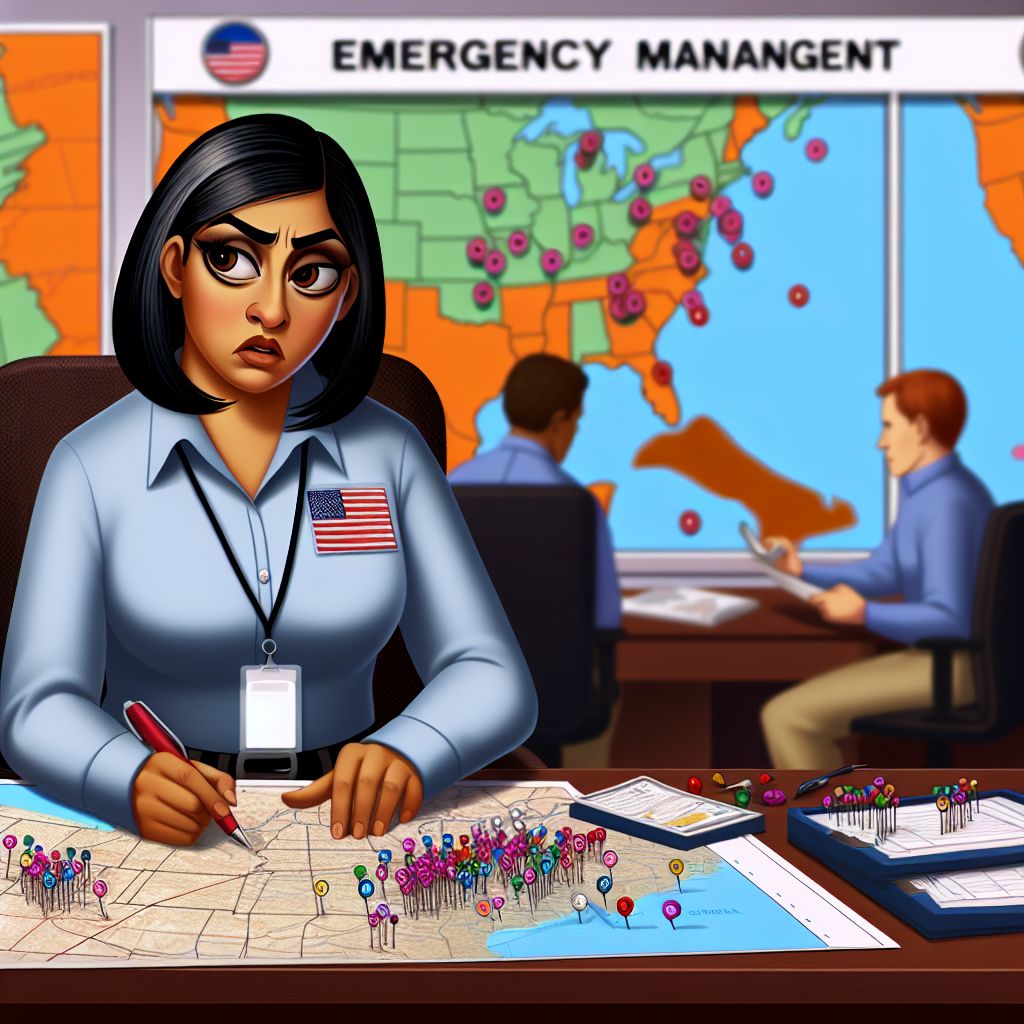Introduction:
Emergency Management Directors play a crucial role in coordinating disaster response efforts.
They are responsible for organizing and managing resources to effectively allocate them where they are needed most during emergencies.
Brief Overview of Emergency Management Director Role:
Emergency Management Directors are tasked with developing emergency response plans, training staff, and coordinating with government agencies and community organizations to ensure a swift and efficient response to disasters.
Importance of Resource Allocation in Emergency Management:
Resource allocation is vital in emergency management as it ensures that essential resources such as manpower, equipment, and supplies are distributed strategically to meet the needs of those affected by the disaster.
Effective allocation of resources can mean the difference between life and death in emergency situations.
Job Responsibilities of an Emergency Management Director:
Emergency Management Directors play a crucial role in ensuring the safety and well-being of communities during emergencies.
They are responsible for developing and implementing comprehensive emergency response plans to effectively address various disasters and crises that may arise.
Developing and Implementing Emergency Response Plans:
One of the primary responsibilities of an Emergency Management Director is to create detailed emergency response plans that outline procedures for responding to different types of emergencies.
These plans must be comprehensive, flexible, and adaptable to various scenarios.
The Director works closely with other team members, government agencies, and community organizations to gather input and expertise in developing these plans.
They must consider factors such as population size, geographic location, and potential threats when creating these guidelines.
Coordinating with Government Agencies and Community Organizations:
Collaboration is key in emergency management, and Directors must coordinate with government agencies and community organizations to ensure a unified response to emergencies.
This involves regular communication, joint training exercises, and sharing resources to enhance preparedness.
Emergency Management Directors establish partnerships with local, state, and federal agencies to leverage their expertise and resources during a crisis.
They also engage with community partners such as non-profit organizations, schools, and businesses to enhance coordination and streamline response efforts.
Leading Response Efforts During Emergencies:
When a disaster strikes, the Emergency Management Director takes on a leadership role in coordinating and managing response efforts.
They oversee the implementation of the emergency response plan, ensure resources are allocated effectively, and provide guidance to response teams.
The Director must remain calm under pressure, make strategic decisions quickly, and communicate effectively with all stakeholders involved in the response.
They work tirelessly to mobilize resources, prioritize actions, and mitigate the impact of the emergency on the community.
Understanding Resource Allocation:
Resource allocation in emergency management refers to the process of distributing available resources.
Transform Your Career Today
Unlock a personalized career strategy that drives real results. Get tailored advice and a roadmap designed just for you.
Start NowIt involves determining where resources will be most effectively used to address emergency situations.
Efficient resource allocation ensures that limited resources are utilized in the most effective manner.
Definition of Resource Allocation in Emergency Management:
Resource allocation in emergency management involves the distribution of personnel, equipment, and funds.
It is crucial for effectively responding to emergencies and ensuring the safety and well-being of the affected population.
Emergency management directors play a critical role in overseeing resource allocation efforts during emergencies.
Importance of Efficient Resource Allocation:
Efficient resource allocation ensures that resources are used effectively to address emergency situations promptly.
It maximizes the impact of available resources and minimizes waste or redundancy.
Proper resource allocation can help save lives, reduce property damage, and expedite recovery efforts.
Factors to Consider When Allocating Resources:
- Severity and scope of the emergency: The scale of the emergency dictates the amount and type of resources needed.
- Availability of resources: Identifying and mobilizing available resources is crucial for effective allocation.
- Prioritization of needs: Assessing and prioritizing the most critical needs helps allocate resources efficiently.
- Coordination and communication: Effective coordination among agencies and clear communication are essential for successful resource allocation.
- Flexibility and adaptability: Resource allocation plans should be flexible to accommodate changing emergency conditions.
- Evaluation and feedback: Continuous evaluation of resource allocation effectiveness allows for adjustments as needed.
Resource allocation in emergency management is a dynamic and complex process that requires careful planning, coordination, and adaptability.
By understanding the definition, importance, and factors to consider when allocating resources, emergency management directors can effectively manage resource allocation efforts.
This management helps mitigate the impact of emergencies and protect the community.
Explore Further: Probation Officer Role in Juvenile Justice System
Types of Resources Managed by Emergency Management Director:
Human resources
Financial resources
Equipment and technology
Communication networks
Human Resources:
Effective emergency management involves the coordination and utilization of human resources.
The Emergency Management Director oversees the recruitment, training, and management of personnel assigned to respond to emergencies.
This includes first responders such as firefighters, law enforcement officers, medical personnel, and volunteers.
The Director must ensure that these individuals are properly trained and equipped to carry out their duties during emergency situations.
Transform Your Career Today
Unlock a personalized career strategy that drives real results. Get tailored advice and a roadmap designed just for you.
Start NowFinancial Resources:
Financial resources are crucial for emergency management efforts.
The Emergency Management Director is responsible for securing funding to support the necessary infrastructure and operations during emergencies.
This includes budgeting for equipment, training programs, and other resources needed for effective response and recovery.
The Director must also be prepared to allocate funds efficiently and effectively to address immediate needs during a crisis.
Equipment and Technology:
Emergency management requires the use of specialized equipment and technology to respond to and mitigate disasters.
The Emergency Management Director must ensure that the necessary equipment, such as emergency vehicles, medical supplies, and communication devices, are available and in working condition.
Additionally, the Director must stay updated on the latest technology and tools that can enhance emergency response efforts, such as GIS mapping systems and drones for reconnaissance.
Communication Networks:
Effective communication is essential for coordinating emergency response efforts and disseminating information to the public.
The Emergency Management Director oversees the development and maintenance of communication networks that connect all stakeholders involved in emergency management, including government agencies, first responders, and community organizations.
The Director must establish protocols for communicating during emergencies, ensuring that information is accurate, timely, and accessible to all those affected.
Find Out More: What Makes a Good TSA Officer: Key Traits and Qualities
Challenges Faced in Resource Allocation:
During times of emergency, one of the most critical tasks for an Emergency Management Director is managing resource allocation.
This process involves identifying, sourcing, distributing, and monitoring resources to ensure they are utilized effectively and efficiently to address the needs of the affected population.
One of the primary challenges faced in resource allocation is dealing with limited resources during large-scale emergencies.
When a major disaster strikes, the demand for resources such as medical supplies, food, water, shelter, and personnel often exceeds the available supply.
This scarcity can lead to difficult decisions being made regarding which areas or individuals receive assistance.
Another key challenge is balancing competing needs for resources.
In an emergency situation, there are numerous competing priorities that must be addressed simultaneously.
For example, first responders may require medical supplies while shelters may need food and water.
It is essential for the Emergency Management Director to prioritize these needs and allocate resources accordingly to ensure the overall safety and well-being of the affected population.
Transform Your Career Today
Unlock a personalized career strategy that drives real results. Get tailored advice and a roadmap designed just for you.
Start NowFurthermore, ensuring equitable distribution of resources presents a significant challenge.
In times of crisis, there is often a risk of resources being unequally distributed, leading to certain groups or geographical areas receiving more assistance than others.
This can be particularly challenging when dealing with vulnerable populations who may have limited access to resources or face barriers to receiving aid.
To overcome these challenges, Emergency Management Directors must adopt a strategic and coordinated approach to resource allocation.
This involves establishing clear protocols and guidelines for prioritizing resource distribution, coordinating closely with other agencies and stakeholders, and regularly assessing and adjusting resource allocation based on changing needs and conditions.
Effective resource allocation is crucial for managing emergencies and ensuring the needs of the affected population are met.
While challenges such as limited resources, competing needs, and equitable distribution may arise, it is essential for Emergency Management Directors to address these issues proactively and collaboratively to maximize the impact of available resources and mitigate the impact of disasters.
- Limited resources during large-scale emergencies
- Balancing competing needs for resources
- Ensuring equitable distribution of resources
Find Out More: Daily Duties of a Sheriff and Deputy Sheriff
Strategies for Effective Resource Allocation:
- Priority should be given to critical needs in resource allocation.
- Establish clear communication channels to ensure efficient coordination.
- Utilize resource management software to optimize allocation processes.
- Train staff on resource allocation protocols to enhance efficiency.
Effective resource allocation is crucial for emergency management directors to maximize the utilization of available resources during crises.
By employing strategic approaches, directors can ensure that resources are allocated efficiently and effectively to address urgent needs.
Prioritizing critical needs:
One of the key strategies for effective resource allocation is to prioritize critical needs during emergencies.
By identifying and focusing on the most pressing requirements, emergency management directors can ensure that resources are allocated where they are needed the most.
This approach helps in addressing immediate threats and preventing further damage.
Establishing clear communication channels:
Another essential strategy is to establish clear communication channels among all stakeholders involved in resource allocation.
Effective communication is vital for coordinating efforts, sharing information, and making timely decisions.
By fostering open lines of communication, emergency management directors can ensure that resources are allocated based on real-time needs and priorities.
Utilizing resource management software:
Resource management software can be a valuable tool in streamlining the allocation process.
Such software allows directors to track available resources, monitor their distribution, and analyze usage patterns.
By leveraging technology, directors can make data-driven decisions and optimize resource allocation to meet evolving demands effectively.
Training staff on resource allocation protocols:
Ensuring that staff members are well-trained on resource allocation protocols is essential for efficient resource management.
Transform Your Career Today
Unlock a personalized career strategy that drives real results. Get tailored advice and a roadmap designed just for you.
Start NowBy providing comprehensive training, directors can empower their teams to make informed decisions, allocate resources judiciously, and respond effectively to emergencies.
Training also helps in building a cohesive and coordinated approach to resource allocation within the organization.
Delve into the Subject: Park Ranger’s Role in Preserving Historic Sites

Case Studies on Successful Resource Allocation:
One example of successful resource allocation in emergency management is during Hurricane Katrina in 2005.
Emergency management directors effectively coordinated resources such as food, water, medical supplies, and shelters to support the affected population.
Another case study is the response to the California wildfires in 2018.
Emergency management directors strategically allocated resources such as firefighting equipment, manpower, and evacuation resources to combat the wildfires and protect communities.
During the COVID-19 pandemic, emergency management directors efficiently allocated resources such as personal protective equipment (PPE), ventilators, and testing kits to healthcare facilities and frontline workers to respond effectively to the public health crisis.
Impact of Effective Resource Allocation on Response Effectiveness:
Effective resource allocation directly impacts the overall effectiveness of emergency response efforts.
When resources are allocated efficiently and strategically, emergency management teams can respond promptly and effectively to emergencies.
This can save lives and minimize damages.
Proper allocation of resources ensures that critical needs are met in a timely manner.
For example, during a natural disaster, timely allocation of resources such as food, water, and medical supplies can prevent further casualties.
It can also provide essential support to affected individuals.
Efficient resource allocation enhances coordination and communication among response teams.
By ensuring that resources are distributed based on priority needs and available data, emergency management directors can facilitate seamless collaboration among agencies.
This maximizes the impact of response efforts.
Effective resource allocation also promotes resilience and recovery in communities affected by emergencies.
By strategically allocating resources for post-disaster recovery efforts, emergency management directors can support the rebuilding process.
This includes restoring essential services and facilitating the recovery of affected individuals and businesses.
Transform Your Career Today
Unlock a personalized career strategy that drives real results. Get tailored advice and a roadmap designed just for you.
Start NowSuccessful resource allocation plays a crucial role in enhancing the effectiveness of emergency response efforts.
By prioritizing needs, coordinating resources, and promoting collaboration, emergency management directors can ensure a more efficient and impactful response to emergencies.
This ultimately saves lives and reduces the impact of disasters on communities.
Collaborating with Stakeholders in Resource Allocation:
Involving community partners in resource planning.
Coordinating with government agencies and non-profit organizations.
Building relationships with the private sector for resource support.
Collaborating with stakeholders is a crucial aspect of effective resource allocation for emergency management directors.
It involves working closely with various individuals and organizations to ensure that resources are allocated efficiently and effectively during emergencies.
One key stakeholder group that emergency management directors need to involve in resource planning is community partners.
These partners can provide valuable insights into local needs and resources, helping to tailor allocation strategies to specific community needs.
By engaging with community partners early on in the planning process, emergency management directors can ensure that resources are allocated in a way that meets the needs of the communities they serve.
In addition to community partners, emergency management directors also need to coordinate with government agencies and non-profit organizations.
These organizations can provide additional resources and support during emergencies, helping to supplement the resources that the emergency management agency has available.
By working together with these organizations, emergency management directors can ensure that resources are coordinated and distributed effectively across all response efforts.
Furthermore, building relationships with the private sector is another important aspect of collaborating with stakeholders in resource allocation.
The private sector can provide valuable resources, such as equipment, supplies, and funding, to support emergency response efforts.
By establishing strong relationships with private sector partners, emergency management directors can ensure that they have access to the resources they need to respond effectively to emergencies.
Overall, collaborating with stakeholders in resource allocation is essential for emergency management directors to effectively allocate resources during emergencies.
By involving community partners, coordinating with government agencies and non-profit organizations, and building relationships with the private sector, emergency management directors can ensure that resources are allocated efficiently and effectively to support response efforts.
Managing Resource Allocation in Emergency Situations
Managing resource allocation is a critical task for emergency management directors.
Transform Your Career Today
Unlock a personalized career strategy that drives real results. Get tailored advice and a roadmap designed just for you.
Start NowThey must make decisions swiftly and effectively based on the needs of the situation.
Understanding the priorities and available resources is essential.
Emergency management directors can allocate resources efficiently to ensure positive outcomes during crises.
Key points discussed include effective communication, strategic planning, and coordination with stakeholders.
Directors play a crucial role in minimizing the impact of disasters on communities.
Their ability to prioritize needs and collaborate with agencies is essential.
Adapting to changing circumstances also plays a part in successful resource allocation management.
The role of emergency management directors in this regard cannot be overstated.
Their leadership and decision-making skills are indispensable during crises.




